Molecular Tracing of the Geographical Origin of Human Immunodeficiency Virus Type 1 Infection and Patterns of Epidemic Spread Among Migrants Who Inject Drugs in Athens
- PMID: 29020180
- PMCID: PMC5850526
- DOI: 10.1093/cid/cix717
Molecular Tracing of the Geographical Origin of Human Immunodeficiency Virus Type 1 Infection and Patterns of Epidemic Spread Among Migrants Who Inject Drugs in Athens
Abstract
Background: High numbers of human immunodeficiency virus type 1 (HIV-1) infections among people who inject drugs (PWID) have been diagnosed in Athens, Greece, since 2011. We aimed to trace the geographic origin of HIV-1 infection for migrants who inject drugs and to investigate whether transmissions occur more frequently among migrants than among Greek nationals.
Methods: Multiple cross-sectional studies were pooled to assemble all persons diagnosed with HIV-1 in Greece between 1 January 2011 and 31 October 2014. Phylogenetic analyses used maximum likelihood estimation. The hypothesis of ethnic compartmentalization was tested by reconstructing ancestral states of characters at the tips using the criterion of parsimony over a set of bootstrap trees.
Results: Of 2274 persons, 38.4% were PWID. Phylogenetic analyses showed the existence of 4 major PWID-specific local transmission networks (LTNs): CRF14_BG (437 [58.6%]), CRF35_AD (139 [18.6%]), subtype B (116 [15.6%]), and subtype A (54 [7.2%]). Of 184 non-Greek PWID, 78.3% had been infected within the PWID-LTNs. For 173 (94.3%), the origin of their infection was assumed to be in Greece (postmigration). For PWID infected within LTNs, transmissions for subtype A and CRF14_BG occurred more frequently among migrants than would be expected by chance (phyloethnic study).
Conclusions: Our analysis showed that the majority of infections among migrants occurred postmigration. The existence of significant transmission networking among migrants highlights that this population is a priority for HIV prevention. As molecular analysis can estimate the probable country of HIV infection, it can help to inform the design of public health strategies.
Keywords: HIV; injectors; migrants; molecular epidemiology; origin of infection.
© The Author 2017. Published by Oxford University Press for the Infectious Diseases Society of America. All rights reserved. For permissions, e-mail: journals.permissions@oup.com.
Figures



Similar articles
-
Molecular investigation of HIV-1 cross-group transmissions during an outbreak among people who inject drugs (2011-2014) in Athens, Greece.Infect Genet Evol. 2018 Aug;62:11-16. doi: 10.1016/j.meegid.2018.04.010. Epub 2018 Apr 10. Infect Genet Evol. 2018. PMID: 29653216 Free PMC article.
-
Detailed Molecular Surveillance of the HIV-1 Outbreak Among People who Inject Drugs (PWID) in Athens During a Period of Four Years.Curr HIV Res. 2017;15(6):396-404. doi: 10.2174/1570162X15666171120104048. Curr HIV Res. 2017. PMID: 29165088
-
Near Full-length Genomic Sequencing and Molecular Analysis of HIV-Infected Individuals in a Network-based Intervention (TRIP) in Athens, Greece: Evidence that Transmissions Occur More Frequently from those with High HIV-RNA.Curr HIV Res. 2018;16(5):345-353. doi: 10.2174/1570162X17666190130120757. Curr HIV Res. 2018. PMID: 30706819 Free PMC article.
-
Overview of HIV molecular epidemiology among people who inject drugs in Europe and Asia.Infect Genet Evol. 2016 Dec;46:256-268. doi: 10.1016/j.meegid.2016.06.017. Epub 2016 Jun 7. Infect Genet Evol. 2016. PMID: 27287560 Free PMC article. Review.
-
Molecular epidemiology of HIV-1 infection in Europe: An overview.Infect Genet Evol. 2016 Dec;46:180-189. doi: 10.1016/j.meegid.2016.06.033. Epub 2016 Jun 16. Infect Genet Evol. 2016. PMID: 27321440 Review.
Cited by
-
Molecular investigation of HIV-1 cross-group transmissions during an outbreak among people who inject drugs (2011-2014) in Athens, Greece.Infect Genet Evol. 2018 Aug;62:11-16. doi: 10.1016/j.meegid.2018.04.010. Epub 2018 Apr 10. Infect Genet Evol. 2018. PMID: 29653216 Free PMC article.
-
Molecular Epidemiology of SARS-CoV-2 in Greece Reveals Low Rates of Onward Virus Transmission after Lifting of Travel Restrictions Based on Risk Assessment during Summer 2020.mSphere. 2021 Jun 30;6(3):101128msphere0018021. doi: 10.1128/mSphere.00180-21. Epub 2021 Jun 30. mSphere. 2021. PMID: 34190583 Free PMC article.
-
Post-migration HIV acquisition: A systematic review and meta-analysis.Epidemiol Infect. 2024 Mar 1;152:e49. doi: 10.1017/S0950268824000372. Epidemiol Infect. 2024. PMID: 38425215 Free PMC article.
-
The Impact of Human Mobility on Regional and Global Efforts to Control HIV Transmission.Viruses. 2020 Jan 6;12(1):67. doi: 10.3390/v12010067. Viruses. 2020. PMID: 31935811 Free PMC article.
-
Molecular Analysis of Human Immunodeficiency Virus Type 1 (HIV-1)-Infected Individuals in a Network-Based Intervention (Transmission Reduction Intervention Project): Phylogenetics Identify HIV-1-Infected Individuals With Social Links.J Infect Dis. 2018 Jul 24;218(5):707-715. doi: 10.1093/infdis/jiy239. J Infect Dis. 2018. PMID: 29697829 Free PMC article.
References
-
- European Centre for Disease Prevention and Control. Thematic report: migrants. Monitoring implementation of the Dublin Declaration on Partnership to Fight HIV/AIDS in Europe and Central Asia: 2014 progress report. Stockholm: ECDC, 2015.
-
- Hernando V, Alvarez-del Arco D, Alejos B et al. HIV infection in migrant populations in the European Union and European Economic Area in 2007–2012: an epidemic on the move. J Acquir Immune Defic Syndr 2015; 70: 204–11. - PubMed
-
- Álvarez-Del Arco D, Monge S, Rivero-Montesdeoca Y, Burns F, Noori T, Del Amo J. Implementing and expanding HIV testing in immigrant populations in Europe: comparing guideline’s recommendations and expert’s opinions. Enferm Infecc Microbiol Clin 2017; 35:47–51. - PubMed
MeSH terms
Substances
Grants and funding
LinkOut - more resources
Full Text Sources
Other Literature Sources
Medical
Research Materials

